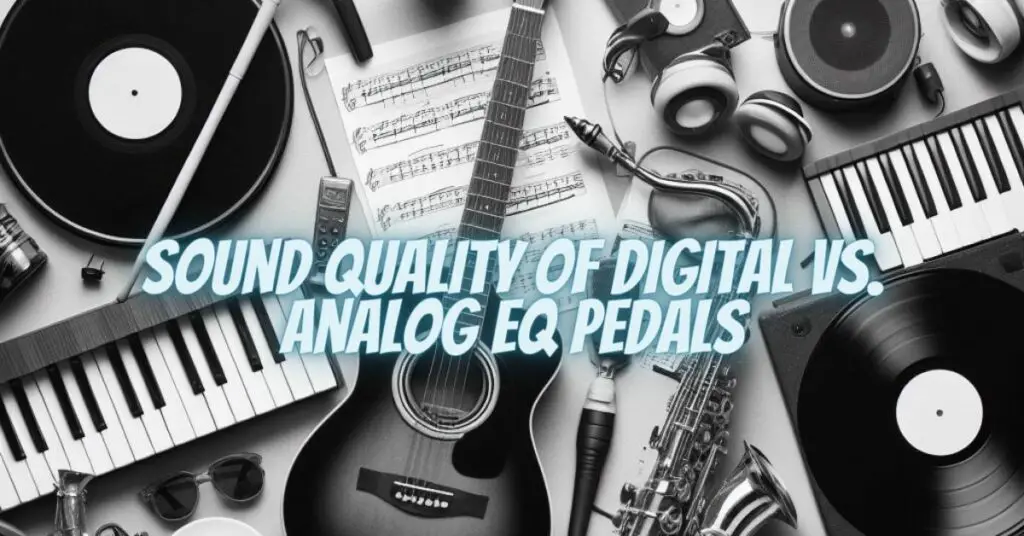The choice between digital and analog EQ pedals is a subject of ongoing debate among guitarists and audio enthusiasts. One of the key factors that fuel this debate is the perceived difference in sound quality between these two types of pedals. In this article, we will delve into the digital vs. analog EQ pedal sound quality debate, exploring the unique characteristics of each and the implications for shaping your guitar’s tone.
Digital EQ Pedals: Precision and Clarity
Digital EQ pedals, like all digital processing, offer a high degree of precision and clarity in their sound. Here’s a closer look at some of the aspects that contribute to their sound quality:
- Precision: Digital EQ pedals provide accurate control over frequency bands, allowing for precise adjustments. This precision is valuable when you need to surgically shape your guitar’s tone to fit a particular mix or musical style. The ability to make fine-tuned adjustments can lead to exceptionally clean and clear results.
- Low Noise: Digital EQs often exhibit low levels of noise, resulting in a quiet signal path. This can be particularly beneficial when working in a studio environment or when dealing with sensitive recording equipment.
- Linear Phase: Some digital EQs feature linear-phase processing, which maintains phase coherence across all frequencies. This can help preserve the natural sound of your guitar, ensuring that the frequencies you’re boosting or cutting maintain their integrity.
- Signal Routing: Digital EQ pedals may offer enhanced signal routing options, such as stereo processing, which can be advantageous for creating immersive stereo soundscapes. Additionally, the ability to reorder effects in the signal chain ensures optimal signal flow.
- Recall and Presets: Digital EQs often come with preset capabilities, allowing you to store and recall different tonal profiles effortlessly. This is especially useful during live performances when you need to switch between songs with varying tonal requirements.
Analog EQ Pedals: Warmth and Character
Analog EQ pedals are prized for their warmth, character, and the unique tonal color they impart. Here’s a closer look at the sound quality aspects of analog EQ pedals:
- Warmth and Color: Analog EQs are celebrated for their ability to add warmth and character to your guitar’s tone. They often impart a certain “color” that many guitarists find appealing. Vintage analog EQ pedals, in particular, are cherished for their distinct tonal qualities.
- Tactile Control: Analog EQ pedals typically feature physical knobs and sliders, providing a hands-on approach to tone shaping. This direct interaction with your sound can result in a more organic, intuitive, and immediate connection with your guitar.
- Headroom and Transparency: Analog EQs are known for their high headroom, allowing them to handle high input levels without distortion. This quality is crucial when you want to make subtle, transparent tonal adjustments without sacrificing your guitar’s dynamic range.
- Simplicity of Integration: Analog EQ pedals are straightforward to integrate into your pedalboard. Their simplicity can be advantageous for guitarists who prefer uncomplicated setups.
The Subjective Nature of Sound Quality
Sound quality, particularly in the context of EQ, is highly subjective. What one guitarist perceives as “better” may not align with another’s preferences. The choice between digital and analog EQ pedal sound quality often depends on the specific sound you’re aiming to achieve and the musical style you’re pursuing.
While digital EQ pedals excel in precision, clarity, and versatility, analog EQs offer warmth, character, and a vintage aesthetic. Some guitarists may prefer the pristine, detailed sound of digital EQ for certain applications, while turning to analog EQ when they desire a more organic, vintage-inspired tone.
The digital vs. analog EQ pedal sound quality debate reflects the diversity of tonal preferences and musical goals in the guitar world. Ultimately, the choice between these two types of pedals should align with your specific needs and the sonic landscape you wish to explore. By understanding the unique characteristics of each and how they impact sound quality, you can make informed decisions when shaping your guitar’s tone.


